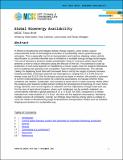| dc.description.abstract | In efforts to decarbonize and mitigate climate change impacts, some sectors require unprecedented levels of technological innovation to substantially reduce greenhouse gas emissions. This is especially true for air transportation and maritime shipping, where vehicle electrification is currently infeasible due to limitations in available energy storage technologies. The use of biomass to produce readily substitutable (“drop-in”) and low-carbon liquid fuels presents a lever to reduce emissions along the lifecycle of the fuel. The potential to scale-up production of such fuels depends on establishing a robust supply chain for biogenic feedstocks and on building and operating cost-competitive, high-throughput biorefineries. The ultimate ‘ceiling’ for displacing fossil fuels with bio-based fuels is set by the supply of primary biomass. Existing estimates of biomass potential are heterogenous, ranging from 2 to 1200 EJ/yr for energy crops and 8-215 EJ/yr for biomass sourced as waste or residue. We provide a summary of current understanding and outline the underlying assumptions to evaluate whether these conditions are realistic, sustainable, and comprise a future which is worth pursuing. Motifs within the analysis point towards sizable barriers limiting the development of bioenergy to cover future energy demand, such as the logistics of collection and the implications of large-scale land use. For the case of agricultural residues, where such challenges can be partially mitigated, we conservatively estimate a global potential of 18±15 EJ/yr. for 2050, compared to a median estimate from meta-analysis of 27.5 EJ/yr. We dive into this apparent discrepancy, identifying multiple sources of uncertainty. Overall, our findings show that bio-energy alone is unlikely to cover the needs of decarbonizing tough-to-decarbonize transportation modes such as maritime shipping and aviation in a sustainable way. | en_US |
